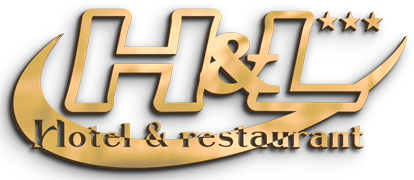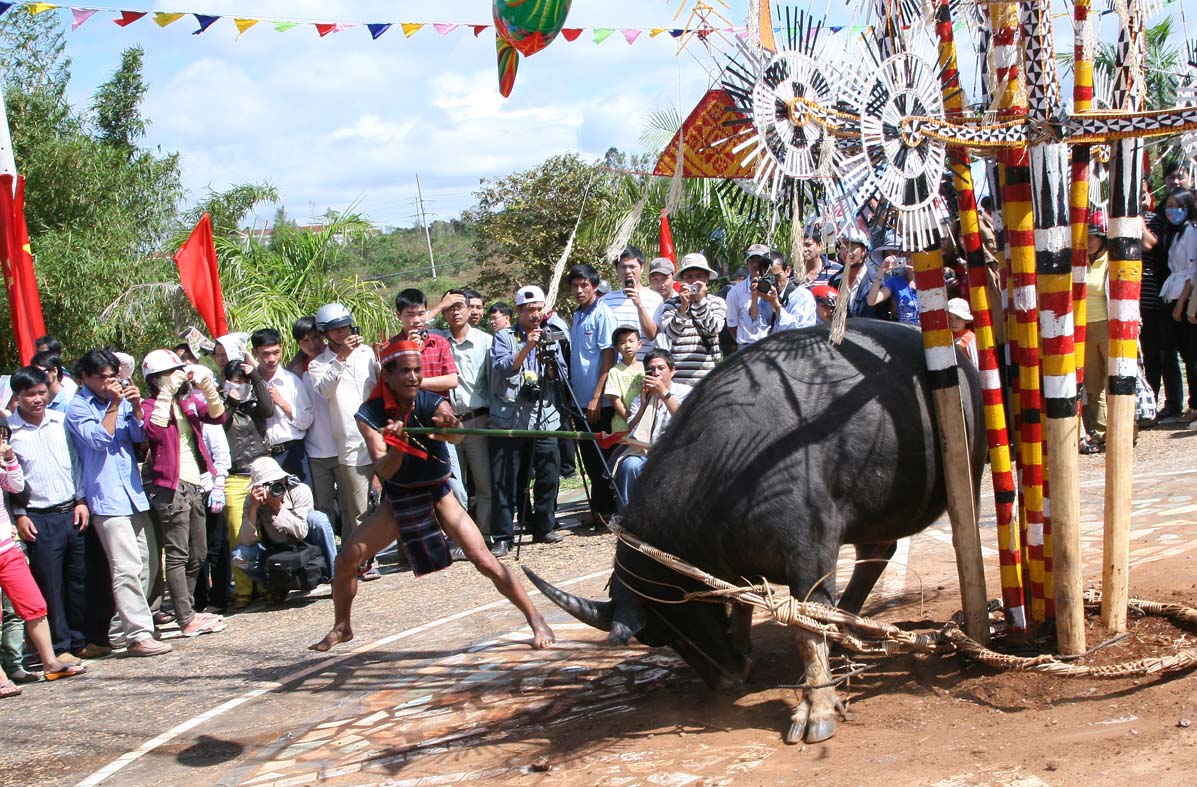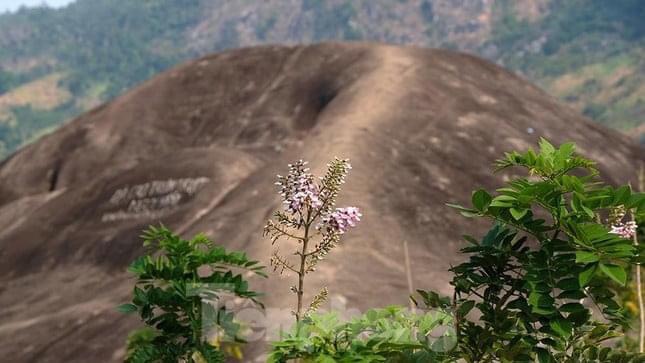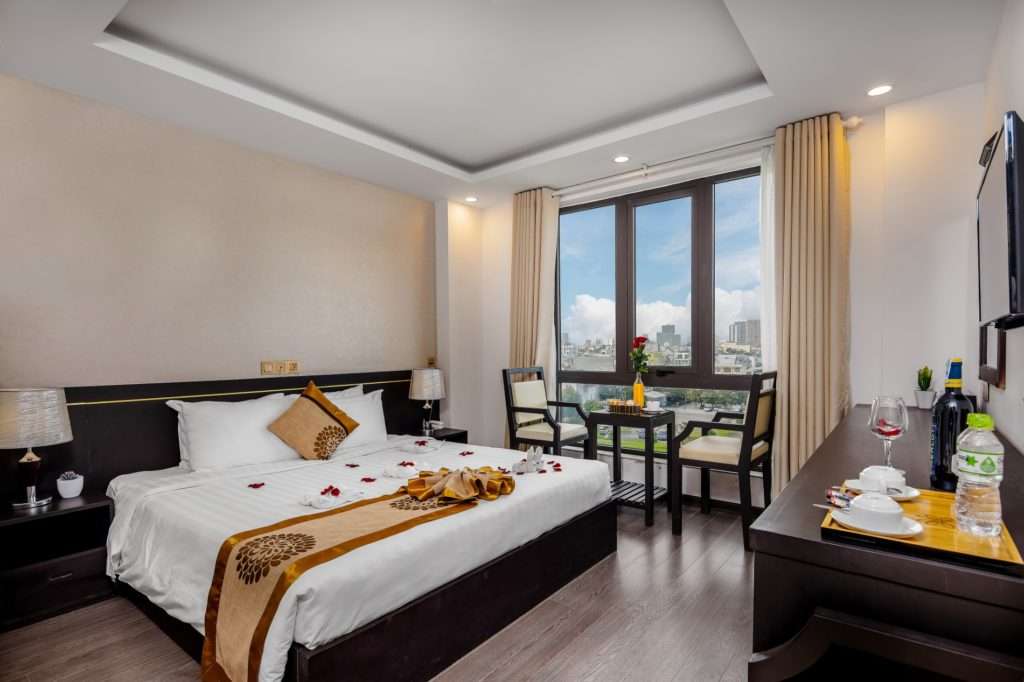UNIQUE CULTURAL FEATURES OF THE DAK LAK PLATEAU
Dak Lak is home to the largest number of ethnic groups with 47 ethnic groups including Kinh, Ede, M'Nong, Gia Rai, Ba-Na, Xo Dang, Cham, Lao Khmer, etc. 70% of the population is the Kinh. Ethnic minorities such as Ede, M'nong, Thai, Tay, Nung... account for nearly 30%.
Especially the traditional culture of the Ede, M'Nong, Gia Rai... with gong festivals, buffalo fighting fesstivals, spring elephant racing; architecture of houses on stilts and communal houses; famous long-standing musical instruments such as gong sets, rock instruments, T'rung; The Central Highlands epics... are valuable tangible and intangible cultural products, of which the "Central Highlands gong cultural space" has been recognized by UNESCO as a masterpiece of oral tradition and heritage. intangible cultural heritage of humanity. All the great cultural traditions of the ethnic groups make up the diversity and richness of the culture of Dak Lak.

Photo: Central Highlands Gong Festival
.png)
Photo: Elephant Racing Festival
.png)
Photo: Buffalo Fighting Festival
Nowadays, when coming to Dak Lak, almost everyone is surprised by an extremely vivid, rich and diverse folklore of the ethnic groups living on this plateau. Those folk cultures are united in diversity and diversity in unity, forming a picture of Dak Lak folklore with different colors, but combining quite harmoniously to create a feature. unique and delicate style of a Dak Lak style, and then formed three cultural lines rich in identity: Indigenous culture of the indigenous peoples of the Central Highlands - Truong Son; culture of ethnic minorities in the North; Kinh ethnic culture (Vietnamese people), with all three nuances of the North - Central - South.
All three cultural lines represent the Vietnamese culture that is present and growing, intersecting, interweaving, and enriching each other, forming a rich, diverse and imbued Dak Lak culture. ethnicity. Therefore, the community culture in Dak Lak is the convergence of the long house culture (Ede, M'nong) with the communal house culture (Jrai, Ba Na, Xe Dang) and the stilt house culture of the ethnic minorities. Northern ethnic minorities and communal house culture of the Vietnamese people. Here, there are both customary laws of trade and village conventions, demonstrating the community's attachment to the construction and development of socio-economic - cultural life, preserving, preserving and promoting the values of the community. national culture.
Beside the community culture is the unique gong culture of the ethnic minorities in Dak Lak, with the integration of the K'nah (Ede), Goong la, Goong pe, and Goong lu (M) 'nong'), Arap (Xe Dang, Jrai) and the Van Kieu, Muong, Thai gong orchestras... throbbed, resounding and resonating, forming a chorus rich in the melodies of the Central Highlands' mountains and forests. In particular, in Dak Lak, gongs of the Central Highlands ethnic groups have been consecrated. It is the only tool for people to communicate with the gods in heaven and earth. It is an indispensable music in community life, cultural activities, rituals and festivals of villages.
In order to preserve and promote the value of gong culture, in 1993, Dak Lak Department of Culture, Sports and Tourism organized a census of gongs in the whole province, initially counting 5,397 sets of gongs. gongs; Up to now, there are only nearly 4,000 different sets of gongs left. At the same time, every year the provincial Department of Culture, Sports and Tourism organizes a gong culture festival from the province to the grassroots level, thereby raising national pride and encouraging the people to participate in preserving the unique gong culture of the people. his clan. In particular, on November 25, 2005, UNESCO recognized the Central Highlands gong cultural space as a "masterpiece of oral tradition and intangible heritage of mankind", further enhancing the gong culture of Dak Lak, Central Highlands are honored and valued in community life.
In addition, there are hundreds of folk songs (rhymes) and over 100 different musical instruments. Each musical instrument has its own unique and attractive features. That is why the music of the ethnic minorities in Dak Lak as well as in the Central Highlands is very rich, diverse, rich in identity, capable of developing and penetrating contemporary cultural life and easily attracting new audiences. The people of the class love the art of national music.
Arriving in Dak Lak, we will participate in agricultural rituals (eating new rice, worshiping rice souls, praying for rain, worshiping water wharf, eating buffalo - celebrating the harvest...), life cycle rituals (naming, blowing ears, growing up, offering health, making brotherhood, wedding ceremony, burial ceremony...) are quite unique and lively of indigenous peoples. Spring festivals of ethnic minorities in the North, traditional festivals of Vietnamese people, are extremely important festivals in the community life of each ethnic group. It carries with it vitality and ideal dreams to wish each family and the whole community to develop and prosper.
Coming to the festival, we will enjoy the songs and dances of the ethnic groups with the sweet and warm taste of can wine and listen to the village elders tell the epic (khan): Dam San, Xing Nha, Dam Di, Khinh Du, Dam Tiong, Dam Trao, Dam Rao... of the Ede ethnic group and the epic (Ot N'rong): De Tieng, Bong - Rong and Tieng, Ndu visit Tieng, Flood water, lake fishing Lau Lach and Tien sell pitted statues... of the M'nong ethnic group and famous epics of many other ethnic groups living in Dak Lak such as the Mo Muong epic, the Thai epic...
There are many other types of culture such as: Visual arts, architecture, handicrafts, fine arts, decorative patterns, dance, food culture, costumes, communication, customary laws and customs. .. in the process of cultural exchange between ethnic groups, it is more complete, having both the unique characteristics of each ethnic group and the common characteristics of the whole community. Along with the culture of the ethnic minorities in the North and the Vietnamese culture, the culture of the indigenous peoples of the Central Highlands in general and Dak Lak in particular still bears many vestiges of the period of clans and tribes.
Here, the management of the village according to the matrilineal regime with the customary community law is quite strict. Each village is managed by land owners and water wharf owners.
The members must abide by the provisions of the customary law and live in harmony with the life of the village community. In such a society, attached to the majestic nature, the people here are very imaginative, full of dreams, indomitable will, resilient, optimistic and liberal souls.
Those are the necessary prerequisites for the culture of the indigenous peoples of Dak Lak to arise, exist and be handed down from generation to generation, becoming a tradition. It is a vivid picture of the society of indigenous peoples through historical periods. In the process of exchange, acculturation, cultural interference, the indigenous peoples of Dak Lak as well as the Central Highlands, the northern ethnic minorities and the Vietnamese still retain their own cultural characteristics. integrate into the common of Dak Lak culture, giving this land a rich, diverse and rich culture.






